TL;DR: What I learned from creating handcrafted GUIs for Python Burp extensions using Swing. Code is at:
The State of the GUI
In April 2019, I had just joined Electronic Arts and I wanted to make a Burp extension. I saw only tutorials on creating a GUI in Jython.

Looks like everyone is either using Java or handcrafted Jython Swing GUIs. I mostly learned it by reading the source of extensions and found this tutorial by Jake Miller A.K.A. Laconic Wolf:
- https://laconicwolf.com/2019/02/07/burp-extension-python-tutorial-encode-decode-hash/
- Search for
Onto the code:to get to the part with Swing.
- Search for
This training by Doyensec is good but not for what I wanted to learn (GUI design). As I mentioned in the tweets, the Python GUI is just modified from a NetBeans generated GUI:
This is something I want to explore later. But to be able to translate the code and do modifications, I needed to figure out how things work internally.
In my blog post [Cryptography in Python Burp Extensions] (/blog/2018-12-24-cryptography-in-python-burp-extensions/#using-jython "Cryptography in Python Burp Extensions"), I started using Jython classes in my Burp extensions and realized I can do the same with Swing (which is what everyone does).
I am documenting what I learned first for my future-self and then for everyone else who wants to take the same path.
Prerequisites
This tutorial assumes you know:
- How to search.
- When in doubt, search for Java and Jython Swing tutorials.
- How to setup Jython in Burp.
- How to use Jython classes.
- How to program in Python.
- How to setup https://github.com/securityMB/burp-exceptions.
Jython Swing Experiments
Basic Tab
To add a tab to Burp, we need to extend and implement the ITab interface.
| |
getTabCaptionjust returns the name of the tab.getUiComponentreturns the new tab.
This extension will not work because getUiComponent is returning nothing and
we get a NullPointerException error. Edit the skeleton then ctrl+click on
the checkbox in front of the extension in Burp's extender tab to reload it.
We start by creating a JPanel. JPanel is a container and can use layout
managers. We will use the BorderLayout.
- BorderLayout tutorial: https://docs.oracle.com/javase/tutorial/uiswing/layout/border.html
- A Visual Guide to Layout Managers: https://docs.oracle.com/javase/tutorial/uiswing/layout/visual.html
| |
We have an empty tab.
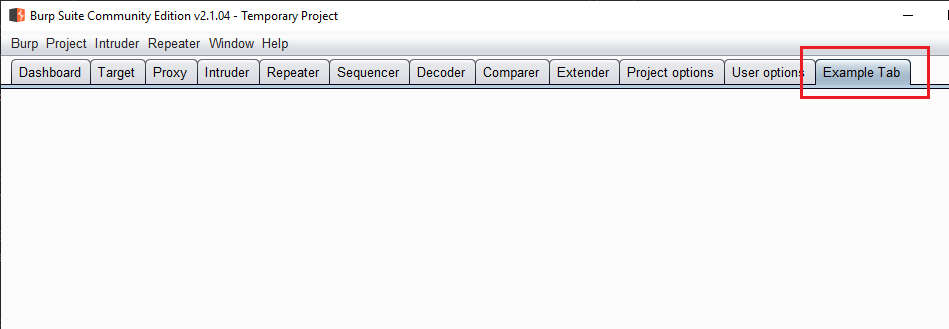 Empty tab
Empty tabUsing the BorderLayout, we can assign positions to components in the panel. These positions are:
PAGE_START-PAGE_END-LINE_START-LINE_END-CENTER
JButton
Adding some buttons that do nothing to show off different positions. A button is
made from the class JButton:
| |
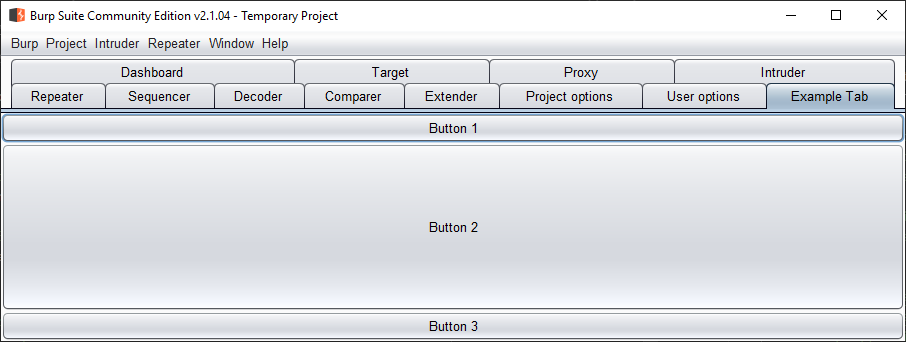 Now we have three buttons
Now we have three buttonsWe used the second constructor for JButton to set the label. We can also set
the fields here. The inherited actionListener field allows
us to do something when the button is clicked. To implement this interface we
need to create and assign the actionPerformed(ActionEvent e) method.
See this tutorial at https://jython.readthedocs.io/en/latest/chapter16/.
| |
 Button clicked
Button clickedPassing an anonymous method like what we did is quick and works if the interface
is simple. We can create a separate module for our GUI and then create and pass
an object to getUiComponent.
See the Twitter client example in https://jython.readthedocs.io/en/latest/chapter16/ to see how it can be done better.
JSplitPane
I want to create something like the screenshot in this blog post from 2012 in a framework for creating Python Burp extensions:
 Reference screenshot
Reference screenshotTo create the left-right split (and also the top-down), we can use a JSplitPane.
| |
The divider automagically resizes based on the items in the panes. In this case, we have added two JLabels. We can move the divider manually.
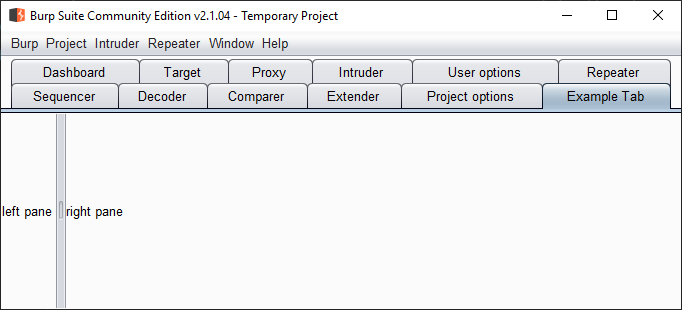 Basic JSplitPane
Basic JSplitPaneUpdate 11 Oct 2019: JSplitPane has a method name setDividerLocation. This
method sets the divider. There are two variants of the method. One accepts an
int parameter which is the size of divider in pixels. This
can be set before the component is painted. The other one accepts a
double parameter and sets a percentage. This does not
work before the component is painted. If you set it, it has not effect.
JScrollPane
We want the left pane to display a list of items. This is accomplished by adding
a JScrollPane to it.
The documentation (the link above) has a lot of text about a viewport and looks
complicated. But we just want to display a list of text in it. First, we add the
items to a JList. Then we pass it to the JScrollPane's
constructor: JScrollPane(Component view).
| |
JList Actions
We can do call a method after each item is selected in the scroll pane. Let's
add the selected item to the label in the right pane. We can do it by assigning
a method to the valueChanged method for the JList.
In the JList docs we read:
The preferred way to listen for changes in list selection is to add ListSelectionListeners directly to the JList. JList then takes care of listening to the selection model and notifying your listeners of change.
See this tutorial for more info:
The ListSelectionListener has one method:
- https://docs.oracle.com/javase/tutorial/uiswing/events/listselectionlistener.html#api
valueChanged(ListSelectionEvent): Called in response to selection changes
Similar to the button action, we define an anonymous method and assign it.
| |
You might wonder why we are adding the selected item to the label instead of modifying the label. It demonstrates the following gotcha.
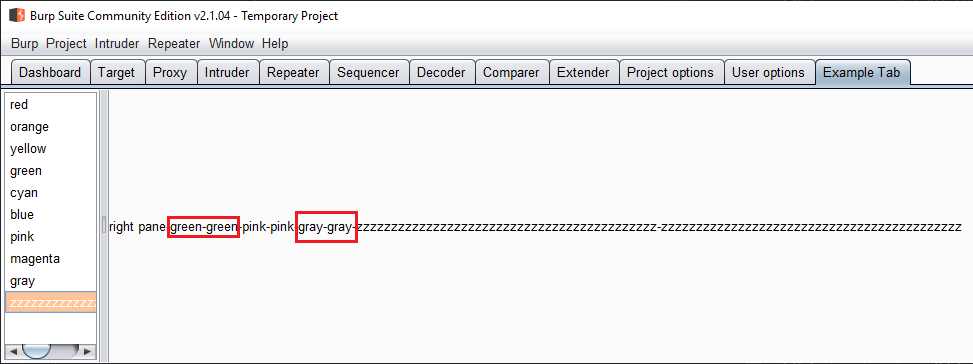 Items is added to the label twice
Items is added to the label twiceEach selected item is added to the label twice. This means that valueChanged
is called twice. I found the answer on stackoverflow.
Long story short, when listening to the events, we need to check if
valueIsAdjusting is set to False. Java sets this to True when we are in a
series of changes that are considered part of a single change. More info:
We can change the the listSelect method as follows:
| |
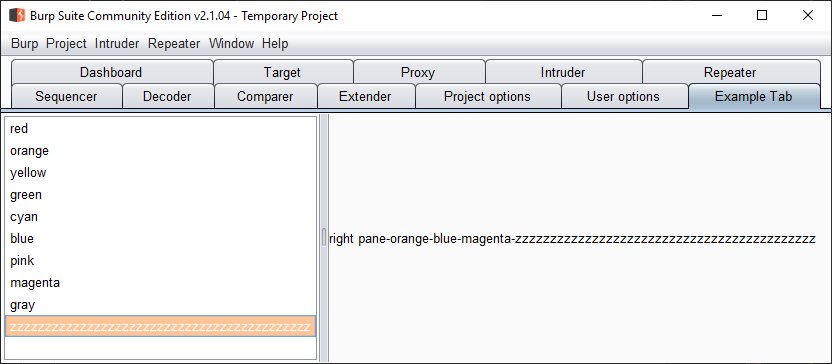 Double add fixed
Double add fixedJTabbedPane
Instead of a label, we want to add two tabs to the right panel and reflect the results to one of them. The main frame in Burp is also a type of JTabbedPane. We are going to:
- Create a JTabbedPane.
- Create two JLabels.
- Add the labels to the tabbed pane from step 1.
- Assign the tabbed pane to the split pane.
| |
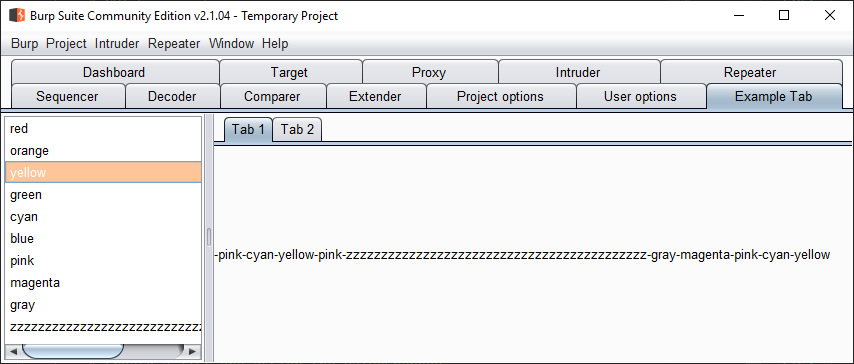 JTabbedPane in action
JTabbedPane in actionStyledDocument
Instead of using a label, we can use a JTextPane and load a StyledDocument in it. We can add text (or other things like images) with specific styles to the document.
The other tab will be a JEditorPane with https://example.net
loaded. We need to change the listSelect method and add items to the
StyledDocument. This can be done with insertString (there are other methods
for different content).
| |
The text is added to tab 1. We are inserting new text to the beginning.
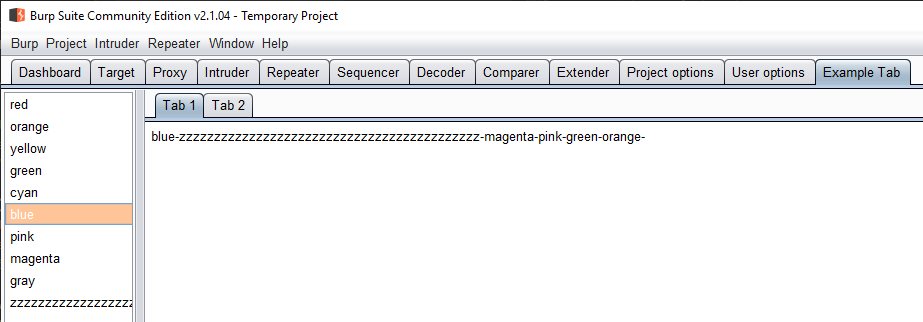 Text added to the JEditorPane
Text added to the JEditorPaneThe other tab shows example.net:
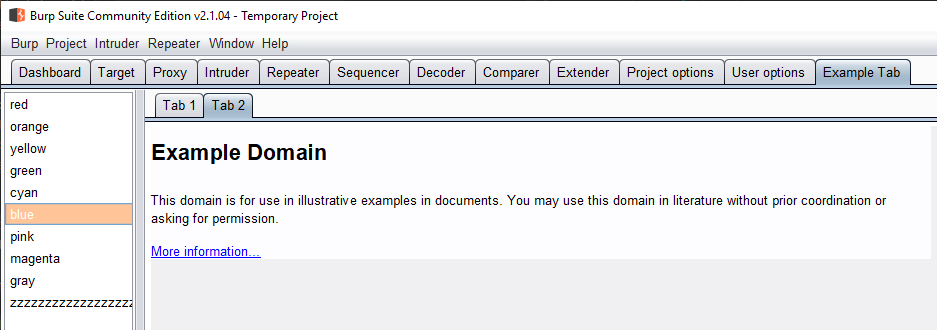 example.net in JEditorPane
example.net in JEditorPaneBoth tabs allow us to edit. To disable editing do tab2.editable = False (or
use tab2.setEditable(False) which is not Pythonic).
Custom Styles in StyledDocument
StyledDocument allows us to create new Styles and add text/graphics/etc as we see fit. This works for a small amount of data.
Styles appear to be in a hierarchy where items further down in the styles tree inherit items from their parents. Everything is a child of the default style 1.
Styles are added to the document with addStyle. The first
parameter is the name and the second is the parent style. Items are added with
insertString (or other inserts).
| |
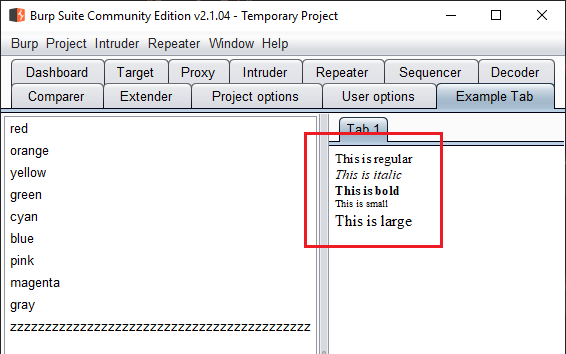 Custom styles
Custom stylesWhat Did We Learn Here Today
We learned how to make Jython Swing GUIs by hand. There are things we did not discuss like checkboxes and radio buttons but the same principle applies.
In the next part, we will see how we can leverage NetBeans (or other GUI designers) to create interfaces. Then we will "translate" the code from Java to Jython using the knowledge we acquired in this post. Knowing how things work allows us to customize the controls to some extent and troubleshoot when things go wrong.
I could be wrong about this but all examples do the same. ↩︎